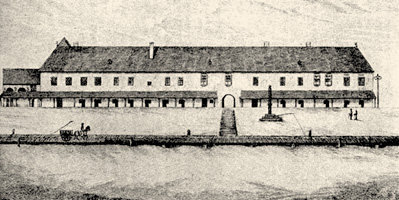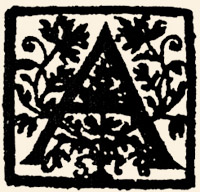
PÁL RHEDA (1596-1619)
The rich market-spot Debrecen belonging to the Transylvanian Principality at that time, became, by the beginning of the 17th century a prominent spiritual center of the Eastern Hungarian region. Its inhabitants were confessionally uniformly the followers of the Helvetian Calvinist reformed church founded in Debrecen by Péter Melius Juhász in the previous century. In the spread and stabilization of this confession printing introduced to the town by Gál Huszár has played a prominent part. From its foundation in 1561 there was continuously a press working in Debrecen.
|
|
Ambrus Derecsei's collection of sermons explaining the Bible
(RMNy 895) |
Beside occasional printings Pál Rheda also issued profitable calendars (RMNy 1031) |
Following the death of the previous printer János Csáktornyai the leading of the printing shop was taken over by Pál Rheda of Lipsia. After Raphael Hoffhalter and András Komlós (Lupius or Lupinus) he was the third Debrecen printer of foreign origin. Very little is known about Rheda's previous life or where he came from, although most probably he was of Leipzig (Lipsia) origin. He was learned, mastering Latin language, as it can be deduced from the dedications he wrote to his own printings. During his activity spanning over a quarter century as town printer he produced more than 80 works. His publication policy can be characterized as a very practical, well outlined balance of religious and secular works.
Beside being in charge of the press Pál Rheda was translating works form German to Hungarian, further, he was also taking part in compiling books. He was the first who, from 1596, consistently differentiated ortographically the sounds u and v in printing. The products of his press were of high quality and representing a masterly skill.
After his death a part of his fortune was inherited by his widow, while the press had fallen to his son Péter Rheda who was in charge of it from 1620 on.

PÉTER RHEDA (1620-1629)
 |
The town hall of Debrecen was ready by 1582. |
Following the publishing practice of his father beside issuing religious works and , works of Hungarian literature, calendars have also regualrly left the press. The majority of his publications were sermons and other religious works by Calvinist authors. As some of the printers employed in the printing shop had no Hungarian knowledge, it was Rheda, ho read the proofs.
After Péter Rheda's death early in 1630 the town council made an inventory of his heritage, and because of the debts in agreement with the widow, the town confiscated the printing shop and the house.
After Péter Rheda's death early in 1630 the town council made an inventory of his heritage, and because of the debts in agreement with the widow, the town confiscated the printing shop and the house.
 |
The newly acquired printer's flowers of Pál Rheda
|

MENYHÁRT FODORIK (1631-1635(1651)
 fter Péter Rheda's death the council of Debrecen agreed with Mehyhért Fodorik to sell him the typography (1633). Still, the town had the right to supervise the activity of the printer as well as the books he issued. Fodorik was a local bookseller and bookbinder with some practice in printing, even if his books did not reach the quality of his predecessors.
fter Péter Rheda's death the council of Debrecen agreed with Mehyhért Fodorik to sell him the typography (1633). Still, the town had the right to supervise the activity of the printer as well as the books he issued. Fodorik was a local bookseller and bookbinder with some practice in printing, even if his books did not reach the quality of his predecessors.
This was the first printer's agreement surviving in Hungary. In this the parts agree that for a sum of 500 forints the printing shop comes to the printer's possession, but his activity will be supervised in all respects by the town council. From that time on the printer carried on an independent publishing policy, moreover, in the sense of this agreement the town had the right to redeem the press if they were not content with the printer.
As the number of printing shops working for or owned by protestants gradually decreased in the Hungarian kingdom, more and more commissions were given to the press of Debrecen. The last product of Fodorik's office bearing his name in the imprint was published in 1651. After this date there was a pause of ten years in Debrecen printing.


<<back to the top <<

LITERATURE:
Régi magyarországi nyomtatványok (RMNy) - Res litteraria Hungariae vetus operum impressorum, 2: 1601-1635, ed. by Borsa Gedeon and Hervay Ferenc. Budapest 1983.
BITSKEY István-D. SZABÓ Ágnes: Rheda Pál könyvkiadói programja. In. Nyomdatörténeti szimpózium. Debrecen 2011, 31-44.
BENDA Kálmán-IRINYI Károy: A négyszáz éves debreceni nyomda (1561-1961). Budapest 1961, 25-28.
V. ECSEDY Judit: A könyvnyomtatás Magyarországon a kézisajtó korában. Bp. 1999, 116.